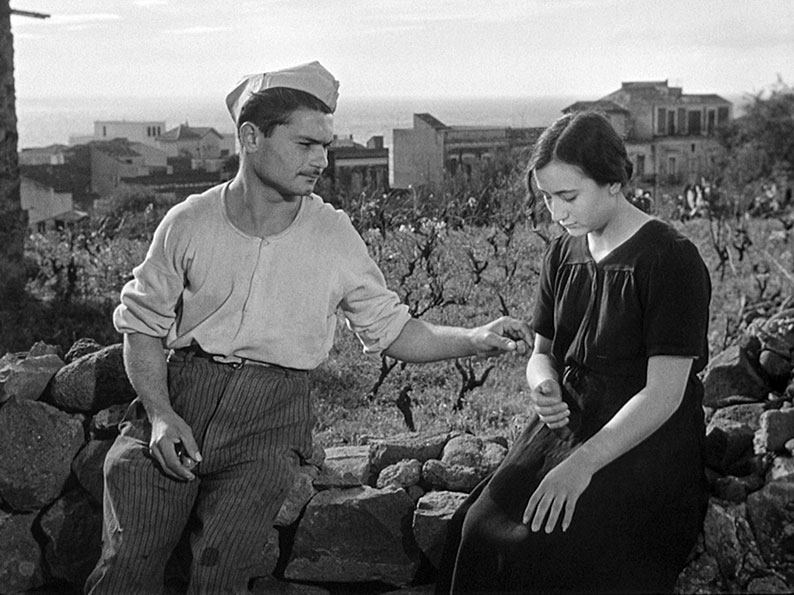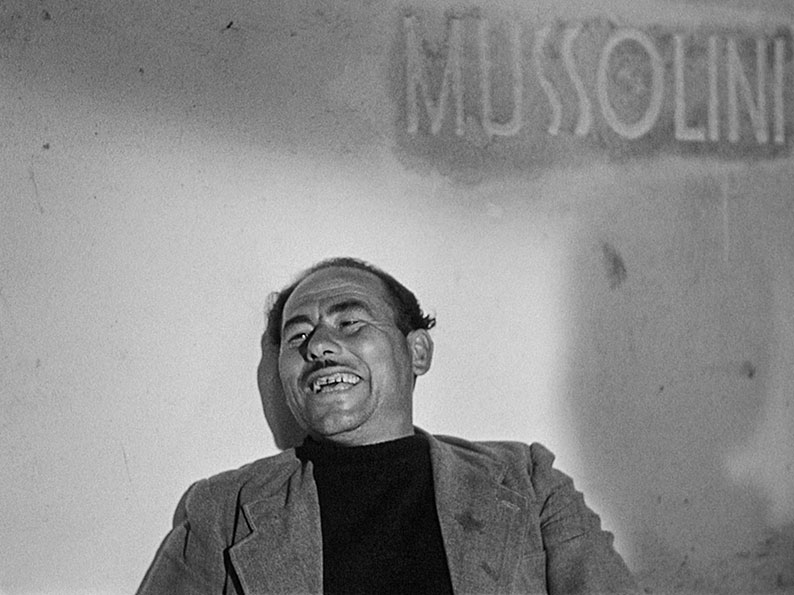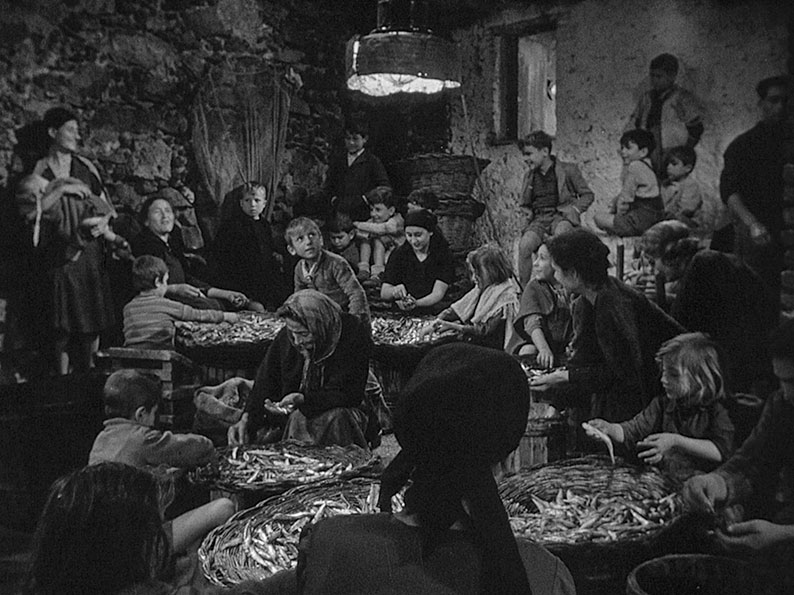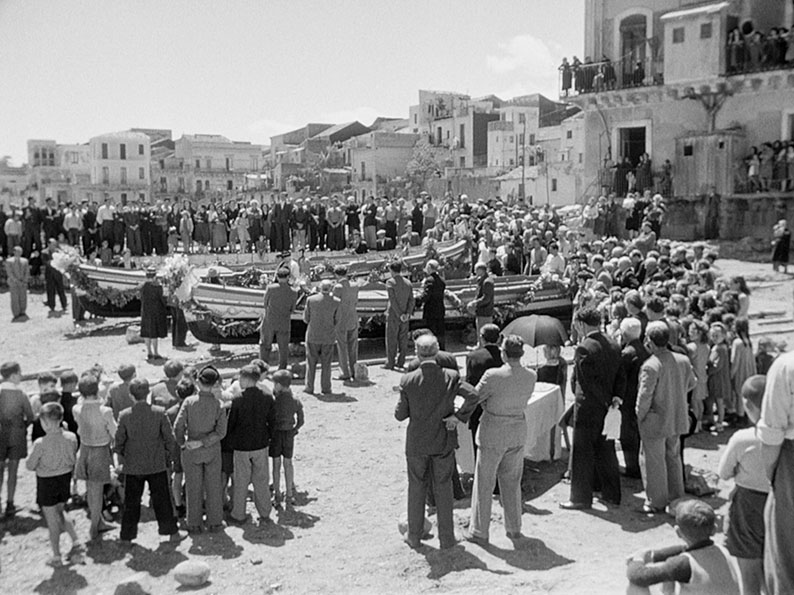|
Aci Trezza, a village on the east coast of Sicily. The Valastro family, led by oldest son ’Ntoni (Antonio Arcidiacono), have been fishermen for decades, but they struggle to make ends meet. Demands for a better price for their catch is met by resistance from the wholesalers. ’Ntoni, having lived on the mainland for some time, tries to form a workers’ cooperative. When that doesn’t work out, the family mortgages their house to buy their own boat...
Nowadays, Luchino Visconti is most often associated with the lush operatics of his later films , often literary adaptations or with historical subject matter or both, beginning with his fourth feature, Senso (1954), his first film in colour. But he began in the neo-realist movement: contemporary subjects, real locations, often using non-actors, telling their stories with little or no studio artifice. Visconti’s debut feature, Ossessione (1943), is often considered the first neo-realist film. (It was an unauthorised version of James M. Cain’s novel The Postman Always Rings Twice, causing issues with its distribution outside Italy. Although it had certainly been shown in the UK before then, it didn’t have a British commercial cinema release until 1985, which is when I first saw it.) 1948 was a peak year for the movement, with the release of Vittorio De Sica’s Bicycle Thieves as well as La terra trema (subtitled on this disc as The Earth Will Tremble, but this is a foreign film most often known by its original-language title), Visconti’s second feature.

The film is set and shot in a real place and none of the actors were professionals, speaking their native dialect rather than standard Italian. They are not credited on screen outside a blanket “pescatori Siciliani” (“Sicilian fishermen”). However, a documentary this is not. It is based on a novel (I malavoglia, by Giovanni Verga, published 1881 – this translates as The Bad Wishes, though its English translation goes under the name The House by the Medlar Tree). It may have been shot in black and white – which did connote realism in 1948 – but it makes use of conventional cinematic language, such as cuts, close-ups and a fair amount of camera movement. It was Godard who said that drama and documentary are closer than might at first appear – a live-action film is a documentary record of the people and places in front of the camera when it was shot, and a documentary is heightened, structured and shaped as much as any drama – but for all its naturalistic trappings, La terra trema is very much the former. It is structured in three acts with a prologue and epilogue, though the scenes were improvised with the non-professional actors and there was no script. The film was shot on location over seven months. Future directors Francesco Rosi and Franco Zeffirelli worked as assistants. This was the first film of cinematographer G.R. Aldo, who had previously worked as a stills photographer. Without drawing too much attention to itself, his work uses deep focus and some complex camera movements, taking the film in the direction of a drama rather than merely a documentary. Aldo went on to shoot Miracle in Milan (1951), Umberto D. (1952) and Terminal Station (1953, aka Indiscretion of an American Wife) for De Sica. He reunited with Visconti for Senso, but died during production in a road accident, aged just forty-eight.
Visconti was a man of contradictions: born to nobility and wealth but a committed Marxist, and at times Communist, who had fought in the Resistance during World War II. Initially funded by the Italian Communist Party, La terra trema was meant to stir up the presumably middle-class-and-upwards cinema audience concerning the plight of the impoverished fishermen. It’s not subtle about it: the wholesaler who overtly mocks ’Ntoni’s plight has a Popolo Mussolini sign on the wall above his head. However, there’s something a little paternalistic about the film. The Sicilian dialect proved a stumbling block for many Italian audiences, so a voiceover narration in standard Italian was added by Visconti and Antonio Pietrangeli. (“Italian is not a language of the poor,” says the caption at the start.) At times this overtly tells us things that it claims are beyond the grasp of the characters on screen, who (at one point) “haven’t grasped the extent of their misfortune”.
La terra trema was indeed originally intended as a documentary, which the Communists intended to use during the Italian election campaign of 1948. Visconti visited Aci Trezza and found that the village was little changed since the 1880s when Verga’s novel had been written. Visconti had long wanted to make a film of the novel, having acquired the rights in 1941, so he took the opportunity to do so, using locals in the cast. Originally the plan was to make a trilogy of films about workers (as well as the fishermen, sulphur miners and farmers) and those exploiting them, taking the workers from defeat (as in the present film) to stalemate and ultimately victory. However, as the project grew, only the first part of the three was filmed.

The film won the International Prize at the 1948 Venice Festival. At first it was seen outside Italy in a version completely redubbed into Italian and shortened by about forty-five minutes. British cineastes could not see it in its original form until a National Film Theatre showing in 1957. Likely as a result of that and other showings, its reputation rose. Bicycle Thieves may have topped the 1952 Sight & Sound poll, but it didn’t make the 1962 one. Citizen Kane was now number one, and it would remain so until 2002, but there at number nine was La terra trema.
La terra trema is released by Radiance on a single Blu-ray disc encoded for Region B only. The film has a U certificate.
The film was shot in black and white 35mm, and the transfer, based on a 2K restoration, is in the correct Academy Ratio, 1.37:1. Particularly in the exteriors, shot in sunlight, the blacks, whites and greys seem true and contrast appropriate, and grain looks filmlike.
The soundtrack is the original mono, rendered as DTS-HD MA 2.0. Dialogue, sound effects and Willy Ferrero’s music score are well-balanced, and lipsynch is generally good – not always the case with Italian films of the period or later, not shot with direct sound but postsynched later. English subtitles are available for the feature and the Italian-language interviews, on as default.
Interview with Christina Newland (10:17)
This piece was newly recorded for this release. Film critic Newland talks about the inception of the film, beginning with the Italian Communist Party giving Visconti a budget of six million lire to make the originally-planned documentary. It was strange that Visconti, given his background, could feel such a connection to the men in this impoverished part of the country, but he did. With the loss of the Communists’ original production money (and their loss in the 1948 elections), the film became a feature rather than a documentary, centring on the one fishing family. Newland discusses the contributions of other principal crew members, such as Francesco Rosi, whom Visconti had met in the theatre, and (uncredited) costume designer Piero Tosi, whose work here is far away from the lavish clothing worn in the historical pieces he did with Visconti such as Senso and The Leopard (1963). There’s an aestheticism which counterpoints the neo-realist ethic: these clothes might be ragged, but they’re elegantly ragged. Newland concludes by noting the regard Michelangelo Antonioni, six years younger than Visconti, had for the film, for him one of the greatest ever made.

Interview with Pietro Ingrao (9:23)
The following three interviews on this disc are all from 2003. Politician and journalist Ingrao talks about his meeting with Visconti in Capri. At first he thought Visconti was a haughty aristocrat for whom filmmaking was a passing whim, and that he and their mutual friends knew more about cinema than he did. Clearly he got that wrong. Ingrao talks about his and Visconti’s wartime activities, with Visconti giving him accommodation when Ingrao and his friends were being hunted by the police for conspiring against the fascists. He discusses the roots of the neo-realist movement, art “based on realism and social awareness” and his involvement in the inception of La terra trema. Verga’s novels, especially I malavoglia, were very useful as “an epic rendition by a conservative author” of the oppression of workers.
Interview with Francesco Rosi (14:00)
Assistant director Rosi says that La terra trema was the point where he first “made contact” with cinema. He had always wanted to work in films but began in theatre. Then the opportunity came to work with Visconti on what was at first to be a small documentary shoot. The small crew took on various roles as the production expanded. One of Rosi’s tasks was to write everything down that was shot, in the absence of an actual script, and to draw each shot as a storyboard, with the dialogue that had been improvised. The other credited assistant director, Franco Zeffirelli, worked with and rehearsed the actors. Rosi is not the first person to say that Visconti could be very demanding to work for and there were tensions between the director and the crew, which came to a head over a dispute over work hours, sometimes eighteen-hour shoots. He once paused the production due to one of Rosi’s drawings not being precise enough as to the height of a broken boat mast. That said, he regards the time he spent working with Visconti as particularly “enriching”, as behind the martinet on set was a very generous man.

Interview with Turi Vasile (3:07)
Vasile went on to become a film writer, director and producer, but at the time was a reporter sent to cover the Venice Film Festival when La terra trema premiered. He went to the press screening and no-one there understood a word of the film. Vasile had to act as a real-time translator so that everyone else could follow the film. At the party afterwards, the younger cast members present were at ease with the gathering, not the case with the older ones. The actor playing ’Ntoni’s father sat alone in a corner. Vasile engaged him in conversation, but the man thought the food was too fancy and he’d have preferred pasta and beans. Too old to go to sea, he would often go to the docks and spend his day watching the boats.
Image gallery
Seventeen images, beginning with a poster (in colour), followed by stills, all in black and white, navigated via the Next button on your remote.
Booklet
This limited edition contains a booklet with new writing by Stephen Gundle and an archival piece by André Bazin. This was not available for review.
La terra trema was a key film for Visconti and you can see him moving away from his neo-realist beginnings towards the style of his later films. Radiance’s disc, the first of a series of Visconti releases, presents the film well.
|